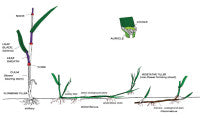Grass Identification - what have we got here?
 ALS botanist, John Handley, says that, with some experience, it is possible to look at a sports surface and make an accurate judgement as to the proportion of different species present. However, as with all skills, this only comes with practice and, in the intervening time, we have to start somewhere.
ALS botanist, John Handley, says that, with some experience, it is possible to look at a sports surface and make an accurate judgement as to the proportion of different species present. However, as with all skills, this only comes with practice and, in the intervening time, we have to start somewhere.
As greenkeepers and groundsmen we are told what we want and what we don't want. Each season we strive to create the conditions conducive to some species and reduce the presence of pest species. I was taught that the definition of a weed is a plant in the wrong place and, as such, Perennial Rye-grass is a weed on a golf green as much as Annual Meadow Grass is a weed on a football pitch.
How do we know what species we have and, more importantly, how do we know that what we are doing, to promote the species that we want, is working? If we are spending £300 for that bag of Bents, how do we know that it has successfully established? We need to recognise the different types of grass species that we have.
There are a number of guides produced by the seed houses which provide some useful information, although most of them use pictures of mature specimens complete with the flower-head, not what we see within the context of our sports facilities. However, this is the best place to get a good idea of the basic 'characters' that can help us differentiate species, because these 'characters' are likely to be present and at a size which makes them readily identifiable.

An invaluable piece of equipment that should be in the pocket of all professional facility managers is a hand lens. A hand lens is more closely related to microscopes than it is to a magnifying glass or 'reading glass', because it is designed to provide relatively high magnification of a small area rather than low magnification of a large area. So, just like a microscope, your eye should be close to one side of the lens and the object will be close to the other side of the lens.
How to use a hand lens
Bring the lens up to the eye you wish to look through. Give yourself extra support by holding it with the back of your thumb across your cheek.
Make sure the object you wish to look at is close to the hand lens, preferably an inch away. Move your head and hands until the sample enters your complete focus. Try to ensure that the object you are observing has plenty of light on it.
An ideal lens would normally have a magnification of x10 and a diameter of 21mm, they are available for about £10 from places such as Summerfield Books or Alan Ecology.

They can be used to help identify plant species and disease too, and provide a wonderful insight into a world that is usually beyond the scope of our eyesight.
The 'characters' I mentioned earlier require further explanation. As in all fields, there is a certain amount of jargon; words which have a specific meaning in the context where they are used professionally. The component parts of the grass plant are identified in figure 1.
The leaves of a grass are arranged in two alternating rows; the sheath and the blade are a single structural unit. The sheath commences at the node and is wrapped around the internode; these are fused in some species to form a cylinder. The auricle is an ear or sickle shaped structure that is found opposite the junction of the blade and sheath. The ligule is a membranous outgrowth at the junction of the blade and sheath.
On the next page is a dichotomous key; this consists of a series of paired descriptions, called couplets. Beginning with the first pair of descriptions, read each thoroughly. Then examine the specimen and decide which description is most appropriate. At the end of each description there is either a species name or a number, indicating the next couplet to examine. Continue in this manner until all the couplets have been exhausted, or until you reach a conclusion as to the identity of the specimen.
Writing down the numbers of the couplets you go to in the key may help define problem areas, in case an incorrect identification is made. Within t
 he key are some technical terms which describe plant parts precisely, figure 1 below should help explain any new or unfamiliar terms.
he key are some technical terms which describe plant parts precisely, figure 1 below should help explain any new or unfamiliar terms.
The standard guide that has been used for many years is Grasses, by Charles Hubbard, first published in 1954, and up to its third publication most recently reprinted in 1992. It has very good line drawings and descriptions though the nomenclature, the current names for the species, is not up to date.
A more comprehensive guide is the BSBI (Botanical Society of the British Isles) Handbook 13, Grasses of the British Isles, written by Tom Cope, Alan Gray and illustrated by Margaret Tebbs. This was published in 2009 and the nomenclature is currently up to date, though within taxonomy things are always changing and the Angiosperm Phylogeny Group 3, after DNA analysis, have reordered a number of species and I'm certain that these alterations will be adopted in the fullness of time, though for now the BSBI guide will be quite sufficient.
Plant breeders have improved the choice of cultivars available tremendously, but not beyond recognition and, given sufficient patience and persistence, all the grass species can be identified, though even professional botanists use full-grown specimens that exhibit as many characters as possible to make their job easier.
With thanks to Ken Adams for the drawings, Matt Gresty from Limagrain for providing access to his trial plots at the STRI site at Bingley, and Pitchcare's Laurence Gale for the loan of his camera.
